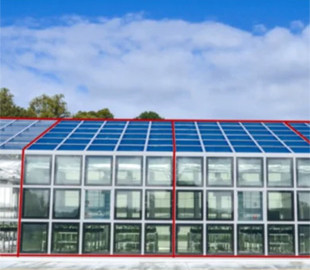
Photovoltaic modules have produced energy and saved water while growing plants in innovative greenhouses.
Engineers from Australia's Murdoch University and ClearVue Technologies have developed new solar windows that can reduce energy and water consumption in greenhouses. The results of the study were presented in an article published in the journal Cleaner Engineering and Technology.
To test their technology, the team designed and built a greenhouse in Perth, Australia, with highly transparent photovoltaic windows on the roof and walls. It consisted of four rooms, each 8 m long and 6 m wide. Room 1 was glazed with conventional ultra-clear low-iron glass, while rooms 2, 3 and 4 used solar glass. It had a direct visible light transmittance (VLT) of about 60% and a total (direct and diffuse) VLT of about 70%, with an energy conversion efficiency of about 3.3% and an electrical output of 30-33 W-peak/m2.
A total of 153 transparent solar windows were installed in the greenhouse. They could power fans, air conditioners, blinds, and ventilation shutters. Surplus energy produced by the photovoltaic installations was also exported to the grid. At night, the greenhouse depended on grid electricity for operation. The solar modules use some of the captured sunlight to generate electricity, allowing the remaining sunlight to pass into the greenhouse for plant growth and food production. Two types of polyvinyl butyral (PVB) structures were used, including PVB-1, with a lower doping concentration for windows with higher transparency, and PVB-2, with a slightly higher luminescence. The solar glass in Room 2 used two interlayers of PVB-2; Room 3 used a combination of PVB-1 and PVB-2, while Room 4 used a single PVB-1 interlayer paired with a regular PVB interlayer.
Over two growing seasons (July to December 2021 and March to September 2022), the study authors measured the yield of 18 different crops grown indoors, as well as electricity production and water consumption. During the tests, the rooms with photovoltaic windows used 57% less electricity and 29% less water.
The photovoltaic windows affected plant growth. Common garden crops such as tomatoes, kidney beans, chickpeas, lettuce, spinach, mustard and bell peppers maintained the same yield levels in the sunroom as in a regular room. At the same time, the yield of snow peas in the sunrooms increased by 12%. Broadleaf crops suffered a noticeable decrease in biomass and yield or did not reach maturity when grown in the “sun” rooms.
With the results, the team created a computational model and predicted how a greenhouse with solar windows would perform in different locations around the world. It was virtually placed in Rio de Janeiro, Brazil; Beijing, China; New Delhi, India; Los Angeles, California, USA; New York, New York, USA; Haifa, Israel; and Paris, France.
“The computational model showed that a fully glazed solar greenhouse could offset up to 100% of energy consumption in different parts of the world through the use of adaptive and efficient temperature control methods, potentially enabling a fully self-sufficient greenhouse economy on a global scale,” the team said.
In a comment to PV Magazine, one of the study's authors, Professor Chengdao Li, added that the main concept of this project is to harvest food and energy simultaneously, so that humanity can simultaneously produce food, energy and not harm the environment.

